The ultimate goal of many companies is to provide an exceptional and unforgettable customer experience to maximize customer loyalty and engagement. To arrive at such a result, it is crucial to frequently question your customers to find out their overall level of satisfaction with your customer journey, your employees, your products, and your service delivery. According to Customer Experience Magazine, only 1 in 26 customers would report dissatisfaction when a lived experience is unpleasant!
Be proactive and question your customers at the right time to set things right when necessary. To collect metrics and performance indicators, what better way than to create relevant customer satisfaction survey answers for your personalized satisfaction surveys? By offering your customers the opportunity to respond to the best of their knowledge, you will collect many precise and detailed feedback that will help you improve your customer experience continuously!
How to create relevant customer satisfaction survey answers based on what you want to evaluate? To help you, here are ten types of responses for your satisfaction surveys, as well as eight good practices to follow when writing them.
Potential response types when creating surveys for your clients
Before you write your survey, it is important to think about what you want to evaluate within your company. These metrics and performance indicators to be analyzed will have a considerable impact on the formulation of your questions, but also on your customer satisfaction survey answers. For example, if you want to evaluate your Net Promoter Score, you will need to focus on scale responses. In another case, to analyze an employee’s performance, you can use a closed or binary question.
How do you know what customer satisfaction survey answers are best for your surveys? To help you, here are the ten main types of answers used in customer satisfaction surveys, as well as some of their main features.
1. Numerical scale responses
Numerical scale answers are perfect answers for calculating your company’s performance indicators (KPIs). They are often represented in the form of satisfaction scales offering five to ten customer satisfaction survey answers per survey, depending on the type of indicator assessed.
The scales for the Customer Effort Score (CES) and the Customer Satisfaction Score (CSAT) are offered as a five-answer numerical scale:
- 1 = Very satisfied;
- 2 = Satisfied;
- 3 = Neutral;
- 4 = Dissatisfied;
- 5 = Very dissatisfied.
The Net Promoter Score (NPS), meanwhile, offers ten scores to calculate the rate of probability that a customer recommends you:
- A score of 0 to 6, for detractors who have almost no chance to recommend your company;
- A score of 7 to 8, for liabilities that have a neutral opinion of your company;
- A score of 9 to 10, for promoters who are likely to recommend your business to a relative.
The results of these numerical scales will then help you calculate the scores of the three main KPIs related to your business.
- The Customer Satisfaction Score (CSAT): The overall level of customer satisfaction with the lived experience. For example, in a satisfaction survey, ask “What is your overall level of satisfaction with our service?” , then propose scale responses to determine your customer satisfaction score.
- The Net Promoter Score (NPS): The chance rate of being recommended by your clients to members of their entourage. To find out this score, ask “On the proposed scale, how likely are you to recommend us to a friend or a colleague?” The result will allow you to target your detractors and promoters, as well as rectify the situation in case of customer dissatisfaction.
- The Customer Effort Score (CES): The level of effort provided by your client to gain access to your services. For example, for a restaurant customer satisfaction survey, ask your customer, “How much effort did you have to put in to book online?”
With numerically scaled customer satisfaction survey answers, you will be able to find out everything about performance indicators, overall customer satisfaction, and your referral rate. It is a must for making informed decisions based on your organization’s concrete data.

2. Scale responses in matrix form
Matrix answers are a type of scale question used to calculate the different types of performance indicators as well as metrics relevant to your business. Similar to the customer satisfaction survey answers in the form of numerical scale, it is often composed of five numerical responses to calculate the Customer Satisfaction Score and Customer Effort Score, or ten numerical responses to calculate the Net Promoter Score.
The matrices consist of a box with one to ten columns (the scale representing the choices of answers) as well as different rows describing the elements to be evaluated. Unlike a numerical scale, matrices can evaluate several elements at once. However, these elements must have the same modalities and customer satisfaction survey answers so as not to confuse the client.
In order to respond, the client must check the proposed point that best reflects their opinion. The matrix will allow her to have a better overview of the questions answered and to think less about the proposed options. This technique is great for saving several minutes of completion when you have many scaled questions in a single customer satisfaction survey!

3. Scale responses in the form of emotions
Customer satisfaction survey answers for a scale in the form of emotions is an excellent type of clear and concise response, especially to evaluate your Customer Satisfaction Score as well as your Customer Effort Score. This scale in the form of an emotion barometer facilitates the understanding of the proposed answers thanks to its graphic style in emojis. It reduces ambiguities while adding a visual and pleasant touch that will make your customers want to complete your survey.
In addition to being clear and pretty, these customer satisfaction survey answers also allow your customers to associate an emotion with the lived experience. It will thus be easier for them to respond according to their level of satisfaction or irritation with a problem encountered.
However, scale responses in the form of emotions are limited to five responses, calculating the Net Promoter Score impossible. However, using such a response scale is relevant in many contexts!
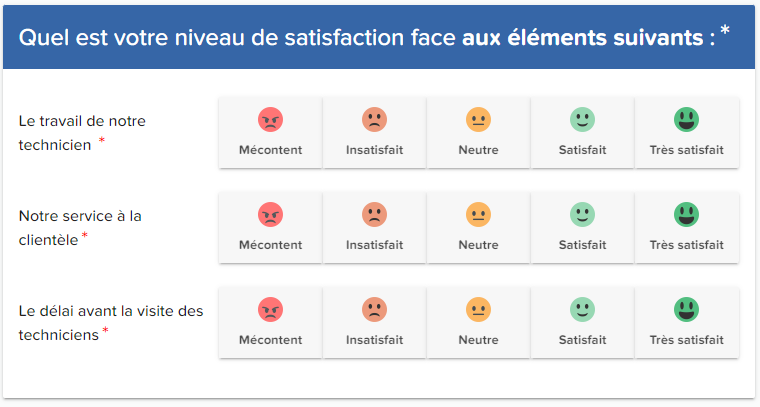
4. Scale responses in the form of stars
Customer satisfaction survey answers in the form of graphical stars scale are a great way to evaluate your products, services, or even the referral rate of your customers. For example, you could ask your clients:
- “How satisfied are you overall with your last purchase?”
- “How would you rate the quality of our services?”
- “How satisfied are you with our customer support?”
Then, suggest that you answer under a graphic scale between one and five stars, similar to an online review. These scores will then be translated in the same way as a numerical scale:
- One star: Very dissatisfied with the lived experience.
- Two stars: Dissatisfied with the lived experience.
- Three stars: Neutral in the face of lived experience.
- Four stars: Satisfied with the experience.
- Five stars: Very satisfied with the experience.
This is a great way to collect valuable performance indicators while analyzing the quality of your company’s products and services.
If it is possible to put more than five stars, we recommend that you limit this type of response to five options for a more refined and pleasant graphic style. Thus, it will be easier for the customer to associate their answer directly with the quality of the service received or the product purchased.
5. Responses in a calendar format
Customer satisfaction survey answers in calendar form are to ask a question related to date and then propose a calendar programmed in your survey as a response. For example, you can ask your client:
- “What was the date of your last appointment at our clinic?”
- “What is your birthdate?”
- “When was your most recent purchase at our store?”
Afterward, include a calendar as a response choice to let the client respond to the best of their knowledge. This way, you will get a precise answer that will allow you to calculate customer satisfaction following a service, according to a specific time or period.
For example, you can use this customer satisfaction survey answer to better track customer satisfaction. You will be able to evaluate the frequency of a customer’s purchases, the satisfaction of a patient after a clinic appointment, or even the period of use of a product to better adapt your products and services according to the feedback received.
Secondly, assessing a client’s age using a calendar is also a great way to gather demographic data and gain a better understanding of client satisfaction based on a specific age group. This way, you will know your target clientele and will be able to better adapt to their satisfaction as well as their current needs.
6. Binary responses
Binary customer satisfaction survey answers consist of two predefined choices offered during a survey For example, you can ask:
- “How well did our customer support meet your needs?”
- “Does our service meet your expectations?”
- “Are you satisfied with the use of your recent purchase?”
Then, you can propose customer satisfaction survey answers such as:
- “Yes” or “No”;
- “Absolutely” or “Not at all”;
- “Agree” or “Disagree”;
- “True” or “False”.
Clear, concise and to the point, this type of response is ideal to allow the client to respond quickly to your survey. These two unique customer satisfaction survey answers reduce the amount of time you give for reflection. In addition, for the editor, the short and few answers also make the survey easier to create.
However, if they know the highest response rate, binary responses collect fewer data and have fewer nuances than other types of responses. In fact, these short and not very detailed answers do not allow you to understand in depth the satisfaction of your customers, nor their personal preferences regarding your products and services. It is therefore advantageous to use these customer satisfaction survey answers for general questions at the beginning of your survey and then to propose more detailed answers towards the end of the survey.
7. Dropdown responses
Drop-down responses are multiple-choice closed answers with only one possible answer. This method of response is ideal for questions whose customer satisfaction survey answers are numerous and short.
Drop-down lists allow participants to better understand the context of a question. With the help of the list, they can discern at a glance all the options available to them and choose the one that suits them best. In addition, the dynamic and clean appearance of this type of response makes it an excellent choice for satisfaction surveys on mobile platforms.
We recommend that you use the drop-down lists sparingly. Since they require more than one click and offer more than two detailed answers, these lists require customers a certain amount of time to complete. Keep this advice in mind when writing your terms and customer satisfaction survey answers for your surveys!
8. Multiple-choice answers with only one possible answer
Multiple customer satisfaction survey answers with only one possible answer are the most common type of customer satisfaction survey answers. This is a predefined answer choice for a question asked. Despite the many closed answers available to them, your respondent must choose the one that best suits them.
For example, you can ask your client:
- “What type of service did you receive?”
- “Which of the following is your favorite product?”
- “What do you think is the main area we should improve on?”
Next, provide your respondent with a list of predetermined options. Your client will choose the answer that best suits them, allowing you to identify:
- The type of service received;
- The most purchased product;
- The main sources of dissatisfaction;
- The most recommended improvements;
- And more!
In a survey, multiple customer satisfaction survey answers with only one answer are ideal for asking your customers about specific points in their experience. Although they take longer to write, their optimal response time is more motivating for your participants. In addition, the feedback obtained is easily converted into performance indicators for your company. This is a must to offer your customers a fully personalized service adapted to their preferences!
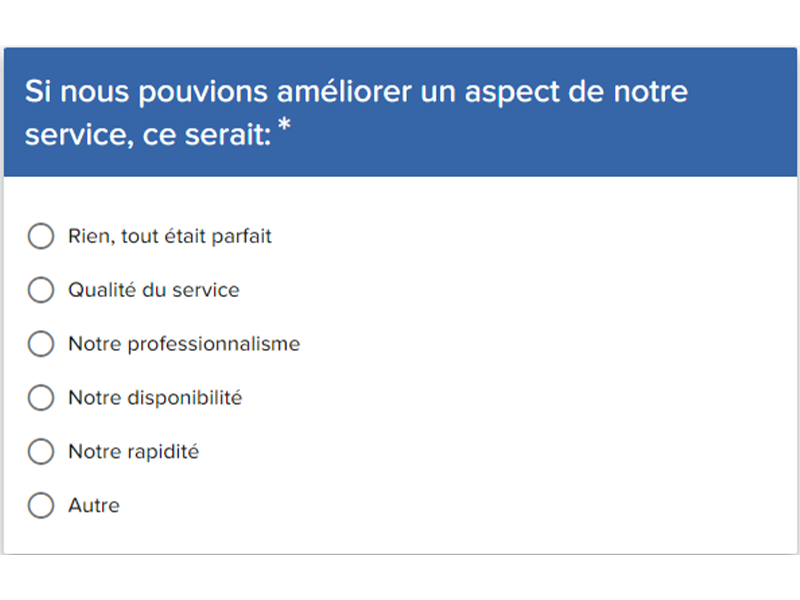
9. Multiple choice answers with multiple possible answers
Multiple choice answers with multiple possible answers are predefined answers. However, unlike single responses, the participant can choose several options that are best for him or her. For example, during a restaurant satisfaction survey, you can ask:
- “What are your favorite dishes on our menu?”
- “What are your favorite pizza toppings?”
- “What dishes would you like to add to our menu?”
- “What could we do better in our restaurant?”
Following these questions, provide your participants with several customer satisfaction survey answers in the form of a check-list. This will allow your customers to select multiple responses without being limited by a single predetermined option. This is an ideal strategy to find out your customers’ preferences and improvement proposals that best suit their expectations. With these multiple answer choices, you can make informed decisions based on your customers’ concrete needs!
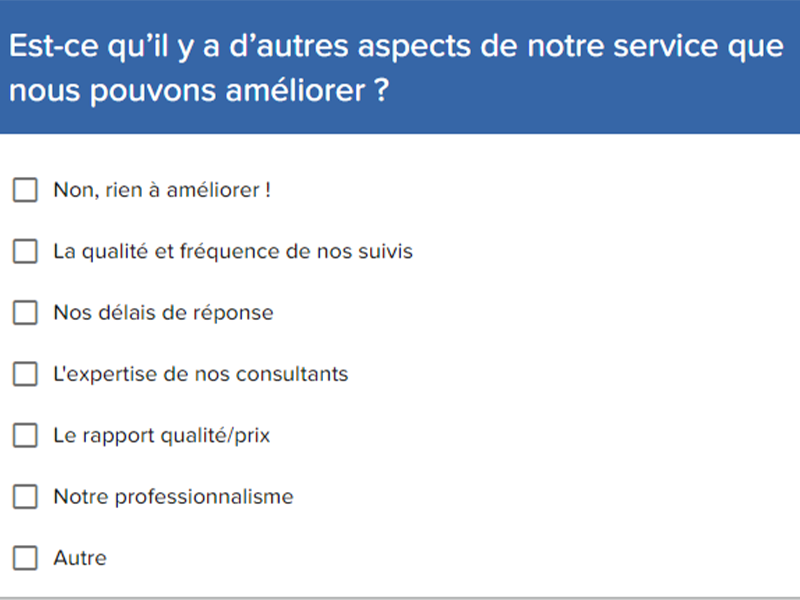
10. Open answers
Open answers are a gold mine of information for your business. During this type of response, your clients have the opportunity to express themselves freely about the experience they have experienced. In addition, they can describe in detail your successes as well as your weaknesses so that you can continuously improve your customer experience. You can even invite your clients to make suggestions for improvements, services and products to be implemented to better match their concrete needs.
When writing open-ended questions for your clients, you can ask:
- “What could we do to improve our services?”
- “Do you have relevant product/service proposals for our company?”
- “What do you think about your recent purchase?”
- “Do you have any comments to add?”
Afterward, leave a blank box to allow your respondents to express themselves freely. You will be able to profit from the many benefits of open responses:
- They allow you to know in detail what your clients think about your service;
- As the writer of the survey, they take much less time to write, as you don’t have to determine a choice of response beforehand;
- They allow you to obtain proposals for improvements (services, products, employee training) from your customers, a considerable asset to better match their expectations while setting you apart from competing companies.
If open-ended responses are easier to write and allow you to gather detailed and relevant information, be aware that they cannot be translated into graphical data for your business. So, rather than collecting KPIs or metrics, you’ll get areas of improvement as well as feedback directly related to the successes and weaknesses of your customer experience. After all, there are as many answers as there are humans: take advantage of one or two well-placed open-ended questions to offer your customers a completely tailored experience to their needs!
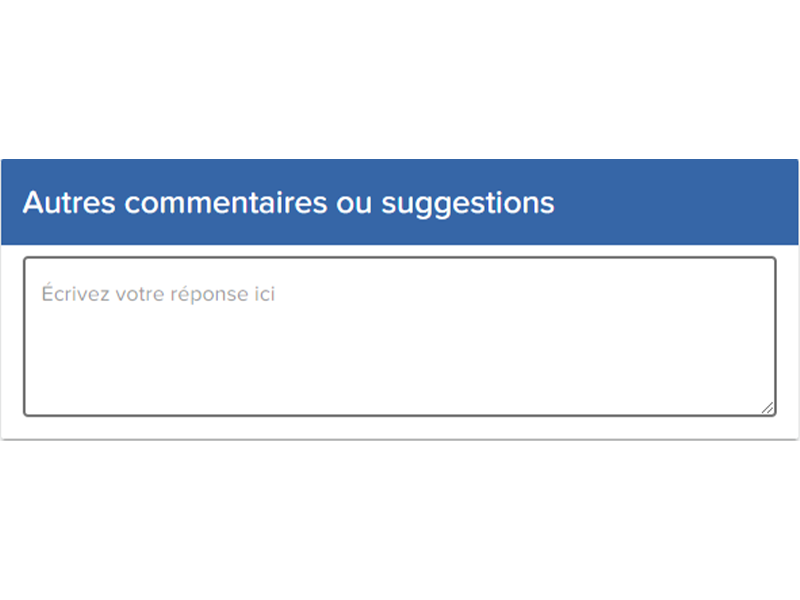
What to pay attention to when creating your surveys
Eight tips for composing your questions and your customer satisfaction survey answers
Now that you know how to choose your customer satisfaction survey answers, it’s time to take action.
To get accurate feedback and metrics, you need to create a relevant, clear and concise satisfaction survey. However, how can you formulate your questions and customer satisfaction survey answers in order to increase your chances of collecting many customer comments?
Here are eight easy-to-follow tips on how to write your customer satisfaction survey answers.
1. Create relevant questions and answers related to what you want to analyze
Before designing your satisfaction survey, you must first understand the metrics and performance indicators you want to analyze. Customer Satisfaction Score (CSAT), Net Promoter Score (NPS), Customer Effort Score (CES), employee performance, evolution of online reviews, and more: this data has a direct impact on the formulation of your customer satisfaction survey answers.
If you write a survey without a specific and determined goal, there is a strong risk that you will lose your way when creating your questions and answers. As a result, your clients will not understand the questions asked of them and will be easily deterred from leaving the investigation before it is completed. In addition, a poorly formulated survey with no real objective could harm your company’s metrics and performance indicators. You may therefore waste your time and that of your clients.
To avoid such a result, think about what you want to evaluate within your organization before you start writing your survey. With this advice, you will have a better idea of the questions to ask as well as the types of customer satisfaction survey answers to offer during your survey. You will therefore receive many relevant feedback that will help you analyze the quality of the experience offered by your company!
2. Write short, clear, and precise questions and answers
Souvent, vos clients répondent à vos questionnaires non seulement pour partager leur opinion, mais également pour vous rendre service. Dans cet ordre d’idée, gardez en tête qu’ils investissent de leur temps pour vous donner des conseils et pistes d’amélioration. La moindre des choses est de leur montrer que vous prenez cette action en considération grâce à un questionnaire concis, clair et précis.
Often, your clients respond to your surveys not only to share their opinions but also to help you. In that vein, keep in mind that they invest their time to give you advice and areas for improvement. The least you can do is show them that you are taking this action into consideration through a concise, clear, and accurate survey.
Here are some tips to follow when writing your questions and customer satisfaction survey answers to reduce your survey time:
- Ask concise questions to the point;
- Be as specific as possible to avoid confusion on the part of the respondent;
- Limit yourself to a maximum of twenty questions;
- Offer mostly closed or scaled responses so that the client has less text to write;
- Test your survey to ensure it does not exceed five minutes of completion.
A short, clear and accurate survey will not only help you achieve a higher completion rate but will also help you achieve better results. In fact, concise questions and answers will help your readers to better understand the data analyzed and to answer to the best of their knowledge. This will facilitate the conversion of feedback into metrics relevant to your business. In turn, you will be able to make informed decisions to improve your continuous customer experience. This is why it is important to pay particular attention to the length of your questions and customer satisfaction survey answers.
4. Avoid biased formulations
When writing your survey, it is important to pay particular attention to the words used. Expressing a personal opinion or asking a biased question can influence your customers to choose an answer that doesn’t reflect what they actually believe.
To get honest and transparent feedback, be sure to adopt a neutral and objective tone throughout your survey.
Here is an example:
- Biased question: “Are you satisfied with the excellent service provided by our friendly representatives?”
- Objective question: “Are you satisfied with the service provided by our representatives?”
Do you see the difference? An objective question is much shorter and gets right to the point. With these neutral formulations, you’ll get a clearer and more transparent opinion from your customers.

5. Offer a balanced response choice
In order to obtain an optimal response rate, your clients must first be interested in completing your survey. To achieve this, it is crucial to offer your customers a choice of questions and customer satisfaction survey answers to create a balanced survey that will capture their attention.
No one wants to read the same question or answer wording for several minutes. A long, tedious, and repetitive survey is highly likely to encourage your clients to abandon your survey, or even push them to straightlining, a practice of always choosing the same answer, or answering completely randomly. For example, a survey that is too repetitive will affect the accuracy of the metrics collected and will likely deter your clients from completing a second survey.
To optimize your response rate:
- Vary the wording and modality of your answers;
- Keep a space between similar questions;
- Give your clients the right to not respond, or to respond anonymously;
- Balance your answer choices for greater reliability.
Remember that variety is the key to an interesting survey. By providing your customers with varied, balanced and anonymous questions and answers, you will get an optimal completion rate as well as relevant and accurate data. Keep this in mind when writing your customer satisfaction survey answers!
6. Focus on one element at a time
When asking a question or proposing an answer, it is important to focus on only one element to evaluate at a time. By formulating “double-sided” questions or customer satisfaction survey answers that are not cross-referenced, you have a high risk of confusing your clients. Such errors can result in answers that do not really represent their opinion. Some will even decide to abandon the investigation, for lack of understanding.
To help you, here are two examples of questions and answers to avoid:
- Double-sided question: “Are you satisfied with our customer service and the quality of our product?”
- Not cross-referenced answers: For the question “I am:”, propose the options “20 to 25 years old” and “25 to 30 years old”.
Customer service and product quality are two separate elements that should not be evaluated in the same question. In the same vein, the customer satisfaction survey answers in the above example doesn’t make sense, since a client can identify two different customer satisfaction survey answers. A 25 year-old could be in the same category as a 20 to 25 years old and 25 to 30 years old, which is problematic.
Here is an example to follow for each of these models:
- Question with one evaluation: “Are you satisfied with our customer service?” and “Is the quality of our products right for you?”
- Cross-referenced customer satisfaction survey answers: I am “under 20 to 25” and “26 to 30”.
In order to create a reliable survey, divide the topics and items to be evaluated into different questions, and then take care to exclude the customer satisfaction survey answers from your survey among them. This will give you clear feedback that will easily translate into metrics and KPIs of your choice. This is a must for the success of your company!

7. Include your open-ended questions at the end of your survey
Think of your satisfaction survey as a conversation with a customer. It would be absurd to ask them directly for proposals for improvement or demographic data without even knowing their overall satisfaction with the experience!
To obtain a better completion rate, take care of the order as well as the modality of your customer satisfaction survey answers. Start with your closed questions first to put the customer at ease. Slowly propose scale or binary questions and then transition to multiple-choice customer satisfaction survey answers.
At the very end, offer your customers to freely express their opinion via open answers. Your readers will be more likely to take a few seconds to respond to the request, as they will already be at the end of your survey. This strategy will provide you with detailed and informative feedback that will help you improve your customer experience. Keep this advice in mind when creating your surveys to give your customers the experience they deserve!
8. Review your survey before final mailing
Imagine: you meet with your colleagues to establish the metrics and performance indicators to evaluate during your next customer satisfaction survey. Then, you spend several hours writing relevant questions and answer choices to get the feedback you need to continuously improve your customer experience. After a lot of hard work, you finally finish creating what you think is the perfect survey.
You’re sending out the survey en masse. After a few minutes, one of your colleagues notices a spelling mistake, a missing question, outdated answers. Finally, a simple test mailing could have saved you all this hassle and saved your customers from receiving a faulty survey that could ultimately harm your brand image.
 To avoid such a situation, always review your survey before you send it out. For example, send a copy of your questions and customer satisfaction survey answers to a family member or co-worker to get an outside opinion. A new eye can make a big difference when it comes to revision!
To avoid such a situation, always review your survey before you send it out. For example, send a copy of your questions and customer satisfaction survey answers to a family member or co-worker to get an outside opinion. A new eye can make a big difference when it comes to revision!
Before the final submission of your survey, also evaluate its completion time. In order to keep readers’ attention, your survey should last no longer than three or five minutes. Think about these valuable tips to maximize your response rate when inviting your customers to complete your customer satisfaction survey.
InputKit, your ally for efficient satisfaction surveys
Do you want a turnkey solution to write questions and customer satisfaction survey answers? If so, InputKit’s customer experience evaluation and improvement solution is ideal for you!
Following a lived experience or a service offered, InputKit allows you to save several hours of management by sending satisfaction follow-ups at the right times. Over, manual follow-ups that take forever! Our solution automatically sends satisfaction surveys via SMS or email, depending on the method of your choice.
With InputKit, you can take advantage of many customer satisfaction survey answers samples to create the perfect survey. You will be able to schedule your surveys to be sent automatically at the optimal time, one to two hours after the experience. Our automated and personalized satisfaction surveys will allow you to collect many relevant customer feedback. This way, you will know your customers’ concrete needs and be able to act accordingly!
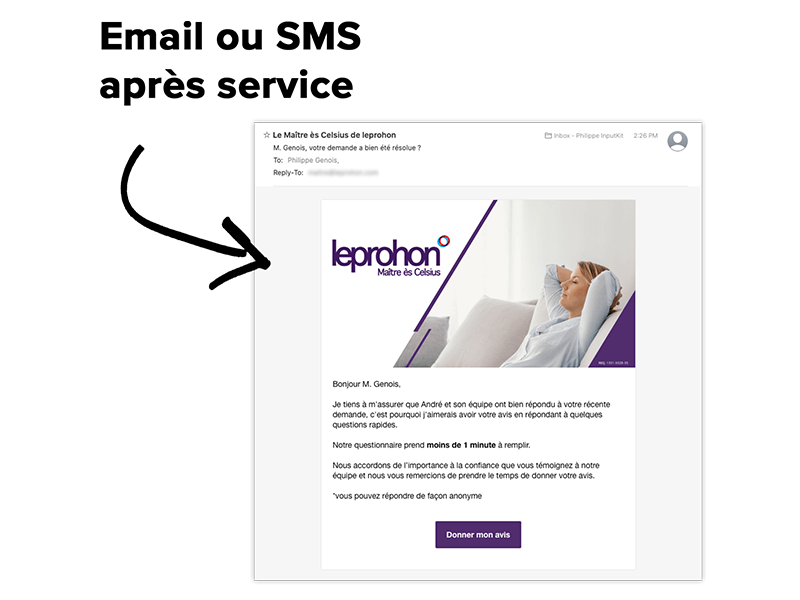
Did you know that our online review functionality ensures that you are targeting only your satisfied customers? For each completed satisfaction survey, you can automatically invite your promoters to leave a positive online review on the platform of your choice. This tool is an asset to improve your e-reputation and optimize your positioning in search results. This will improve your acquisition of new leads while increasing your online visibility!
Plan my free demo at InputKit for high-performance satisfaction surveys
To ensure the quality of your satisfaction survey, follow our best practices. Think about what you want to evaluate and write clear, concise and relevant questions and answers. Avoid biased formulations so as not to influence the respondent’s response. In the same vein, in your survey, propose balanced, often closed customer satisfaction survey answers to obtain metrics that are representative of your clients’ opinions.
To avoid having to manually translate your metrics or confuse your readers, be sure to evaluate only one element per question asked or answer given. Keep your open questions for last so that your customers can answer them with peace of mind. Finally, don’t forget to review your survey to make sure you don’t forget anything.
Do you need professional help to create the perfect customer satisfaction survey? If so, please feel free to contact our team of subject matter experts to schedule a free, fully customized demo of our solution at your convenience. We will be pleased to contribute to your customer success!
Related articles

Receive our best articles and tips by email
Be the first to know about our new articles.








